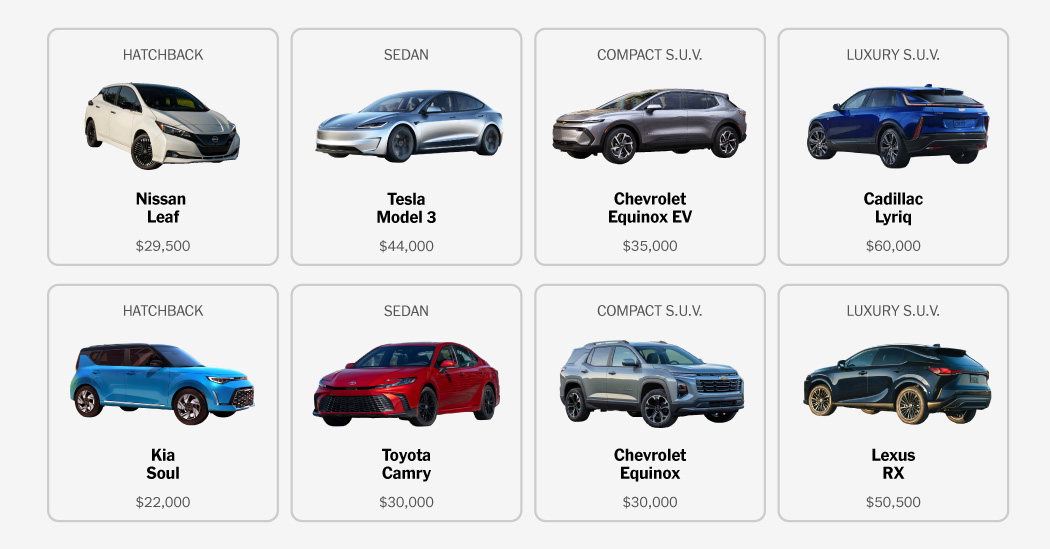Advertisement
Thinking of getting an electric vehicle? E.V.s tend to be pricier than comparable gas cars, but they have lower maintenance costs. And charging with electricity is typically cheaper than stopping at the gas pump. So an E.V. might save you money over time — even without the subsidies that the U.S. government used to offer.
Our calculator takes into account major upfront and ongoing costs of ownership — including gas/electricity and maintenance — and does the math for you. We also give you an estimate of greenhouse gas emissions, if money isn’t your only incentive.
Pick a model, or enter your own details. (You can look up vehicle efficiency here.)
Pick a model, or enter your own details.
How long do you think you’ll own this car?
The average car travels about 11,000 miles each year. (That’s about 30 miles a day.)
Pick your state, or fill in your costs. Our calculations also factor in maintenance: 10 cents per mile for a gas car and 6 cents for an E.V.
Note: We assume you charge at home. If you recharge at a fast charger, raise your electricity cost manually. If you have solar, lower it. Also, these prices are from this year. They can change.
There are other costs that could affect your decision, including insurance and charging infrastructure. If you think you’ll spend more money upfront, or monthly, on one type of car, you can add extra costs here.
It’s hard to know exactly how much CO2 a car produces, but there are two major components: the manufacturing of the vehicle itself and the emissions generated by fueling your drive.
Producing an E.V. typically emits more greenhouse gases than manufacturing a gas car, but E.V.s are much less carbon intensive to drive. We’ve used estimates on emissions from the federal government.
Note: We’re using the data you gave us about how efficient each car is, as well as more information from the preselected models and the state you live in, if you selected them. We’re assuming a total vehicle life of 150,000 miles.
About the data
Price data: For the preselected models, sale prices and m.p.g. are from Car and Driver, and lease prices are Edmunds estimates for the Seattle area. Kilowatt-hour per mile estimates come from the U.S. Department of Energy. Gas prices are from AAA, as of Aug. 11, 2025. Electricity rates are Energy Information Administration data from May 2025. Maintenance costs are estimates from the Department of Energy. A rate of 2 percent annual inflation is applied to gas, electricity and maintenance costs.
Emissions data: The average manufacturing carbon cost of gas and electric cars comes from research by the Argonne National Laboratory; state-by-state and U.S. carbon intensity data comes from Cambium’s mid-case short-run marginal emissions projections for 2025 through 2040. For states that cross G.E.A. regions, we chose the one where the majority of their counties were located. The carbon intensity of gasoline comes from GREET. Emissions are in CO2 equivalent.
Car images courtesy of Nissan, Chevrolet, Cadillac, Kia, Toyota, Lexus and Tesla, Inc.
A ‘Pretty Dreadful Year’: The end of a federal tax credit is expected to push sales of battery-powered cars down, but auto experts believe the market will eventually recover.
Tesla Investigation: The National Highway Traffic Safety Administration is investigating reports that electronic doors on the 2021 Y model couldn’t be opened from outside, trapping people inside.
Musk’s Tesla Investment: The company’s chief executive, Elon Musk, bought $1 billion in stock after the company’s board proposed paying him nearly $1 trillion if he achieves certain performance goals.
Used Car Sales: Electric vehicles on the used market often cost less than comparable gasoline models, making the technology affordable to many more buyers.
Electric Planes: There are dozens of short daily flights to Norway’s islands, and the oil-producing Scandinavian country wants electricity to power them.
Exxon’s E.V. Push: Exxon Mobil, the largest U.S. oil and gas company, is pushing further into the electric vehicle business with an acquisition it says will help it produce graphite, an important battery ingredient, by the end of the decade.
Advertisement











